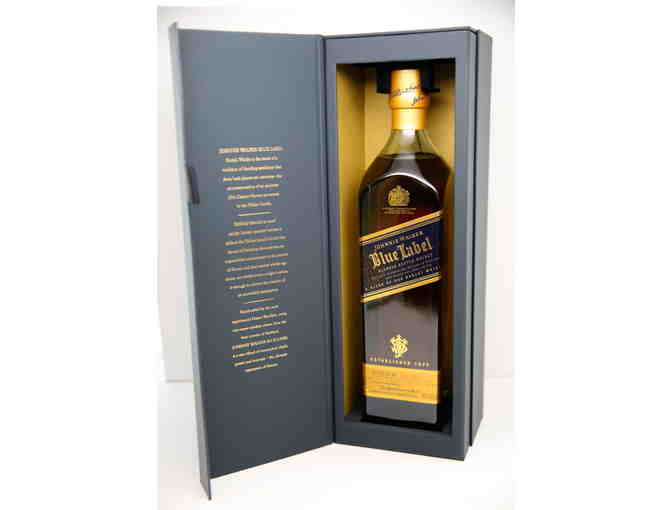Wine, Spirits & Brews
1 Bottle of Johnnie Walker Blue Label, Whisky, Scotland
- Item Number
- 566
- Estimated Value
- 250 USD
- Sold
- 240 USD to Tbedsole
- Number of Bids
- 14 - Bid History
Item Description
The Rarity, the pinnacle whisky of the House of Johnnie Walker – it is the epitome of blending.
John Walker saw the incredible potential of a blended Scotch whisky. A master blender of teas, he dedicated himself to the exacting combination of select whiskies. The results were extraordinary: his blends showed consistently high quality, drop after drop; but the complexity of their flavor also proved unmatched by individual single malts. By combining whiskies from the vast regions of Scotland, an unforeseen depth of flavor revealed itself possible. John Walker began selling Scotch whiskies in his Kilmarnock grocer's shop in 1820 and quickly established an unsurpassed reputation for quality.
To this day, the company selects the finest whiskies across Scotland, from the elegant single malts of the Highlands to the smokiest whiskies of Islay. They have the largest collection of whiskies in the world, an asset that allows their Master Blenders to push the boundaries of their craft with every new creation.
The Blue Label is created to reflect the style of whiskies in the early 19th century. It's created using some of the rarest casks from the Johnnie Walker stocks, the largest in the world. The casks are hand-selected and set aside for their exceptional quality, character and flavor. The character of Blue Label is truly unique; it is complex, powerful, incredibly smooth and retains the Johnnie Walker signature smokiness.
The whiskies that make Blue Label are especially selected for their individuality from some of their rarest stocks. Maturing in oak means that there will always be the exceptional, the unusual and the rare, and these are the whiskies that are used for Blue Label. The Master Blenders at Johnnie Walker have always possessed legendary sensory skills. To produce Blue Label requires not only the skill to sense an aroma in parts per million, but to then weave these together, creating layer upon layer of taste and flavor.
Start by serving Blue Label neat in a tumbler, nosing the whisky carefully.
"The Layers Of Taste Evolve And Resonate With An Elegant Smoky Finish"
Item Special Note
1 Bottle of 0,750L
Scotch Whiskey is made from just three ingredients (malted barley, yeast and water) and is produced under the regulations laid out in the Scotch Whisky Act 1988.
Before even thinking about distilling the barley has to be malted to trigger naturally occurring enzymes that help to change the starch into sugars. To do this the grain is fooled into thinking it is time to start to grow. Therefore the barley is given an average of 3 immersions in water over a period of 48 hours. After roughly five days the starch within the barley has been made available and the grains are putting out shoots and roots (green malt). The grows is afterwards stopped by drying the green malt in a kiln, type of oven. Flavors are introduced by lightning a peat fire under the perforated floor of the kiln. Be aware not all malts are peated, some are dried smoke free or lightly peated.
The next step is to ground the malted grain into a rough flour (grist) which is blown in to a vessel called a mash tun. At the same time it is mixed with hot water from the own source of the distillery. The hot water filter through the grist, dissolving the sugars. This sweet sugar liquid is drawn from the bottom of the mash tun, cooled and pumped to the fermenter. Then yeast is added to the cooled sugar water and fermentation begins for +/- 48 hours. The sugars convert into alcohol while CO2 and heat are given off. At least this liquid is distilled twice in a copper pot still. The first distillation takes place in a wash still giving an alcoholic liquid, which is then charged into a liquid still where the process is repeated. Different from the first distill the stillman will separate the heart of the spirit from the volatile first part and the heavy oily last part. Only the heart of the spirit will then be reduced and transferred into oak casks of 700l. The Scotch whisky industry does use used barrels from Sherry or Bourbon. After the spirit has rested they are blended to create the house style. Before the bottling, the spirit is reduced to bottling strength with demineralised water and chill filtered. After labeling the bottle is ready to be sold
Donated By:
Leigh and Glen Faulk
Coins 4 Kids stores data...
Your support matters, so Coins 4 Kids would like to use your information to keep in touch about things that may matter to you. If you choose to hear from Coins 4 Kids, we may contact you in the future about our ongoing efforts.
Your privacy is important to us, so Coins 4 Kids will keep your personal data secure and Coins 4 Kids will not use it for marketing communications which you have not agreed to receive. At any time, you may withdraw consent by emailing Privacy@frontstream.com or by contacting our Privacy Officer. Please see our Privacy Policy found here PrivacyPolicy.

